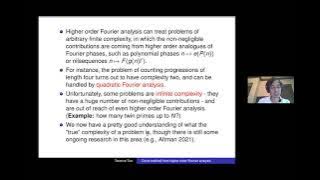
Sets might contain an element that can be identified as an identity element under some binary operation. Performing the operation between the identity element and any arbitrary element in the set must result in the arbitrary element. An example is the identity element for the binary opera
From playlist Abstract algebra

This video introduces the identity matrix and illustrates the properties of the identity matrix. http://mathispower4u.yolasite.com/ http://mathispower4u.wordpress.com/
From playlist Introduction to Matrices and Matrix Operations

Analytic Continuation I The Identity Theorem I Complex Analysis #26
Analytic Continuation and the Identity theorem in Complex Analysis explained. Analytic continuation is a method to expand the domain of an analytic function and the Identity theorem tells us everything we need to know about analytic functions. The Identity Theorem is lowkey the greatest t
From playlist Summer of Math Exposition Youtube Videos

Complex Polynomial Identity Question (3 of 4: de Moivre's Theorem)
More resources available at www.misterwootube.com
From playlist Using Complex Numbers

(New Version Available) Inverse Functions
New Version: https://youtu.be/q6y0ToEhT1E Define an inverse function. Determine if a function as an inverse function. Determine inverse functions. http://mathispower4u.wordpress.com/
From playlist Exponential and Logarithmic Expressions and Equations

Now that we know what quotient groups, a kernel, and normal subgroups are, we can look at the first isomorphism theorem. It states that the quotient group created by the kernel of a homomorphism is isomorphic to the (second) group in the homomorphism.
From playlist Abstract algebra

What is an inverse matrix and how do I calculate it? Free ebook http://tinyurl.com/EngMathYT
From playlist Intro to Matrices

Proof: Identity Element of a Group is Unique | Abstract Algebra
The identity element of a group is unique. We prove this ins today’s video abstract algebra lesson. This is one of the first results you’re likely to prove in an abstract algebra course. It is simple but fundamental, and lets us rest easy knowing something we’d like to be true is indeed t
From playlist Abstract Algebra

Calculus - The Fundamental Theorem, Part 1
The Fundamental Theorem of Calculus. First video in a short series on the topic. The theorem is stated and two simple examples are worked.
From playlist Calculus - The Fundamental Theorem of Calculus

Visual Group Theory, Lecture 4.5: The isomorphism theorems
Visual Group Theory, Lecture 4.5: The isomorphism theorems There are four central results in group theory that are collectively known at the isomorphism theorems. We introduced the first of these a few lectures back, under the name of the "fundamental homomorphism theorem." In this lectur
From playlist Visual Group Theory

Pooneh Afsharijoo, Institut de Mathématiques de Jussieu - Paris Rive Gauche
November 18, Pooneh Afsharijoo, Institut de Mathématiques de Jussieu - Paris Rive Gauche Two new members of Rogers-Ramanujan identities
From playlist Fall 2021 Online Kolchin Seminar in Differential Algebra

Lagrange's Theorem and Index of Subgroups | Abstract Algebra
We introduce Lagrange's theorem, showing why it is true and follows from previously proven results about cosets. We also investigate groups of prime order, seeing how Lagrange's theorem informs us about every group of prime order - in particular it tells us that any group of prime order p
From playlist Abstract Algebra

Visual Group Theory, Lecture 4.3: The fundamental homomorphism theorem
Visual Group Theory, Lecture 4.3: The fundamental homomorphism theorem The fundamental homomorphism theorem (FHT), also called the "first isomorphism theorem", says that the quotient of a domain by the kernel of a homomorphism is isomorphic to the image. We motivate this with Cayley diagr
From playlist Visual Group Theory

YOU CAN'T USE EULER'S IDENTITY TO PROVE THE ANGLE SUM IDENTITIES! | Tricky Parts of Calculus, Ep. 4
I give multiple proofs of the angle sum identities sin(x+y) = sin(x)cos(y) + sin(y)cos(x) and cos(x+y) = cos(x)cos(y) - sin(x)sin(y) from different perspectives. I stress that a very common presentation of these formulas based on Euler's identity e^(ix) = cos(x) + i sin(x) is circular and
From playlist Math

Terence Tao: The circle method from the perspective of higher order Fourier analysis
Higher order Fourier analysis is a collection of results and methods that can be used to control multilinear averages (such as counts for the number of four-term progressions in a set) that are out of reach of conventional linear Fourier analysis methods (i.e., out of reach of the circle m
From playlist Harmonic Analysis and Analytic Number Theory

The Binomial Chu Vandermonde Identity: a new unification? | Algebraic Calculus Two | Wild Egg Maths
We suggest a novel unification of the Binomial and Chu Vandermonde identities, leading to an unusual introduction of the exponential polyseries, along with Newton's reciprocal polyseries. The main idea is to introduce a generalization of Knuth's rising and falling powers notation, which w
From playlist Algebraic Calculus Two

ELEC2141 Digital Circuit Design - Lecture 5
ELEC2141 Week 2 Lecture 2: Combinational Logic Circuits 1
From playlist ELEC2141 Digital Circuit Design

Jason P. Bell: Applications of algebra to automatic sequences and pattern avoidance - Lecture 1
Abstract: We will cover some of the more important results from commutative and noncommutative algebra as far as applications to automatic sequences, pattern avoidance, and related areas. Well give an overview of some applications of these areas to the study of automatic and regular sequen
From playlist Mathematical Aspects of Computer Science

Free ebook https://bookboon.com/en/partial-differential-equations-ebook What is Green's first identity and why is it important? This presentation answers these questions in a gentle way. The ideas are applicable to partial differential equations. In mathematics, Green's identities are a s
From playlist Partial differential equations

Chapter 6: Homomorphism and (first) isomorphism theorem | Essence of Group Theory
The isomorphism theorem is a very useful theorem when it comes to proving novel relationships in group theory, as well as proving something is a normal subgroup. But not many people can understand it intuitively and remember it just as a kind of algebraic coincidence. This video is about t
From playlist Essence of Group Theory